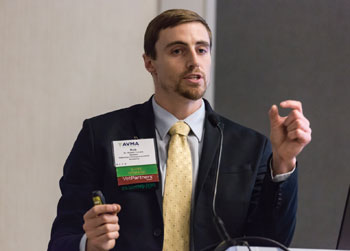Kill the veterinary practice to save it
The exponential growth of technology and changing consumer demand are driving a paradigm shift in the way workplaces are run.
Or, as Elise Lacher described in one of the workshops held during the AVMA Veterinary Leadership Conference, Jan. 10-13 in Chicago, "Shift happens."
"The future is becoming increasingly difficult to predict, and change is needed for businesses of all kinds to remain relevant and effective in our rapidly changing and connected world," she said. "However, most veterinary practices still rely on a way of working designed over 100 years ago for the challenges and opportunities of the industrial age. It's time to call into question some of the long-accepted workplace best practices that no longer serve us."
The challenge is that innovation isn't easy. You can't maintain the status quo and innovate at the same time, said Dr. Sarah J. Wooten, who gave the presentation "Kill the Practice." Innovation takes intention and energy but also is necessary for survival. So, is the veterinary profession ready to change?
Change already here
Innovation is already happening with regard to animal health. For example, the cost required to sequence a genome has decreased from $300 million in 2000 to less than $1,000 today, and by 2022, it will be the cost equivalent of flushing a toilet, said Dr. Robert Trimble, co-founder at Fuzzy Pet Health.
Within veterinary medicine, it feels like a fixed mindset, where we feel like we have to prove ourselves over and over. We don't like to fail.
Dr. Sarah J. Wooten, leadership and personal development speaker
Or take proteomics. Memphis Meats, a food technology company aiming to grow sustainable cultured meat, announced in 2017 that it created the first chicken meat grown without chickens, thereby eliminating the need to breed, feed, and produce an animal to create high-quality protein.
Not to mention what's happening in telemedicine, with companies such as ask.vet charging $99 a year for access to veterinarians; diagnostics, with Pet Lab Express in Athens, Georgia, offering inexpensive blood tests for animals to owners; and house calls, with companies such as Vetted and Fuzzy providing in-home veterinary services mostly in urban areas.
"Competitors will provide things we won't or can't provide," Dr. Wooten said.
Innovation can be difficult in an industry as heavily regulated as veterinary medicine, she added. Further barriers holding back innovation include professional skepticism, complacency, conformity, and excessive processes and bureaucracy.
"Within veterinary medicine, it feels like a fixed mindset, where we feel like we have to prove ourselves over and over. We don't like to fail," Dr. Wooten said. But that can't stop people from considering what they can do to help their practice help more animals and improve efficiency, customer service, client compliance, profitability, and staff morale, she said.
Ways to adapt

Dr. Trimble outlined the following six paradigm shifts in leadership principles shared by progressive, next-stage organizations:
- From an operating system of "predict and plan" to one of "experiment and adapt."
- From a "hierarchical pyramid" structure to a "network of teams" structure.
- From directive leadership and centralized authority to collective leadership and distributed authority.
- From dependence on extrinsic motivators to unleashing intrinsic motivation.
- From a focus purely on profit to purpose and values.
- From secrecy to radical transparency.
Greg O'Brien, co-founder of the O'Brien Veterinary Group that owns 13 practices around Chicago, has adopted a policy of self-managed teams that make decisions autonomously. One of the most important ways the practices use this model, he said, is deciding how to plan for the year. The practices gather together annually, present their individual clinic plans, and learn from each other. The practices also are empowered to solve their own problems instead of leadership making decisions that trickle down.
One of the biggest challenges, he said, was giving up decision-making control as an owner and trusting that team members would take up the mantle by making decisions and taking responsibility. "It requires building a team of adults who want to handle problems. And staying the course when things go sideways. The temptation to grab control back is big," O'Brien said.
But the benefit is that the teams have proven to be much better decision-makers in solving their problems than he would be. And for him as a leader, he said, "I can focus on growing the organization and buying practices and thinking about the future rather than solving problems and telling people what to do."
Dr. Amanda Bisol, co-owner of the Animal Medical Clinic in Skowhegan, Maine, and VLC attendee, agreed that empowering employees is the first step toward innovation. "Make them feel safe in their job. So many are afraid of being fired. Have them give you feedback. Encourage them to say something when they have issues. And knowing who should help them with those issues" should be the job of an owner, she said. Allow associate veterinarians to schedule, order, and budget. Have them take ownership, and give them the skills to do what is expected of them.
Dr. Wooten had attendees thinking about the following if they were their own competitor:
- What would you do to put your practice out of business?
- Where are the biggest threats? Which ones surprised you?
- Now that you know what the competition could do to you, how do you stop them?
"Sometimes you have to destroy your business in order to save it," Dr. Wooten said.